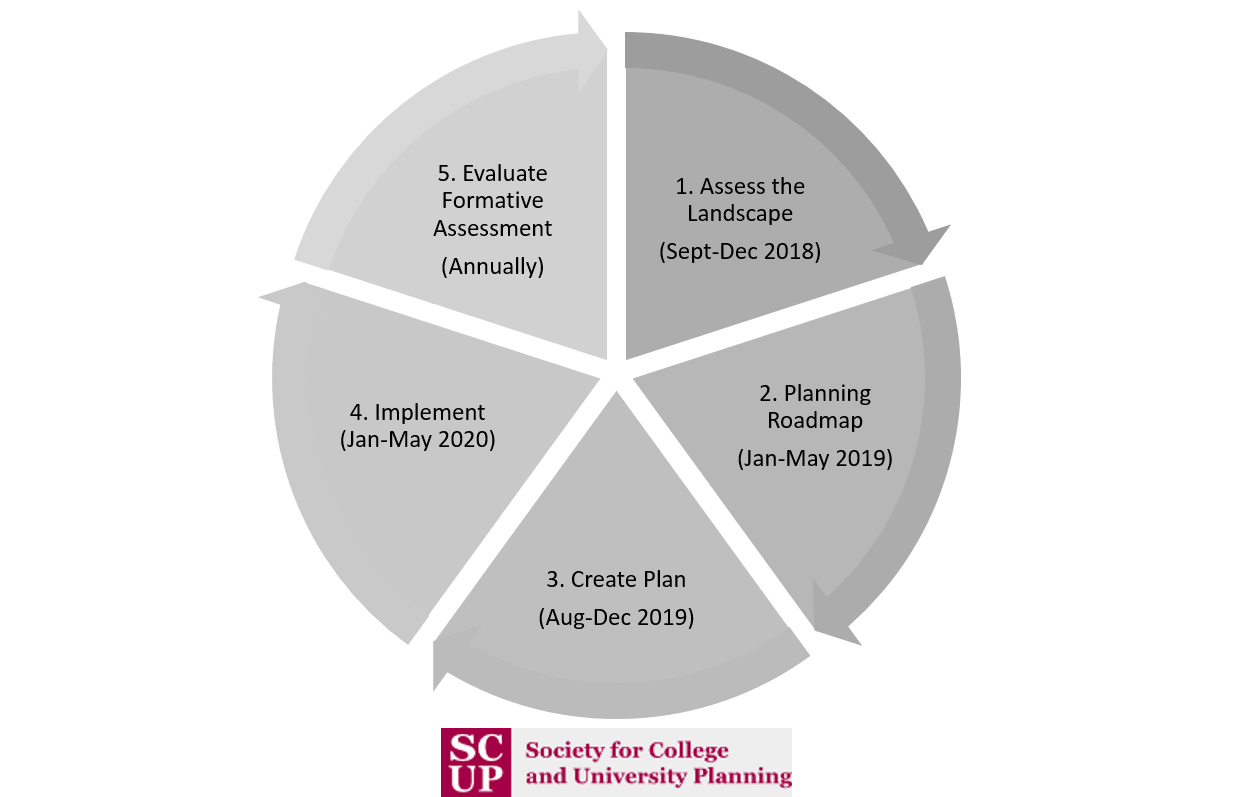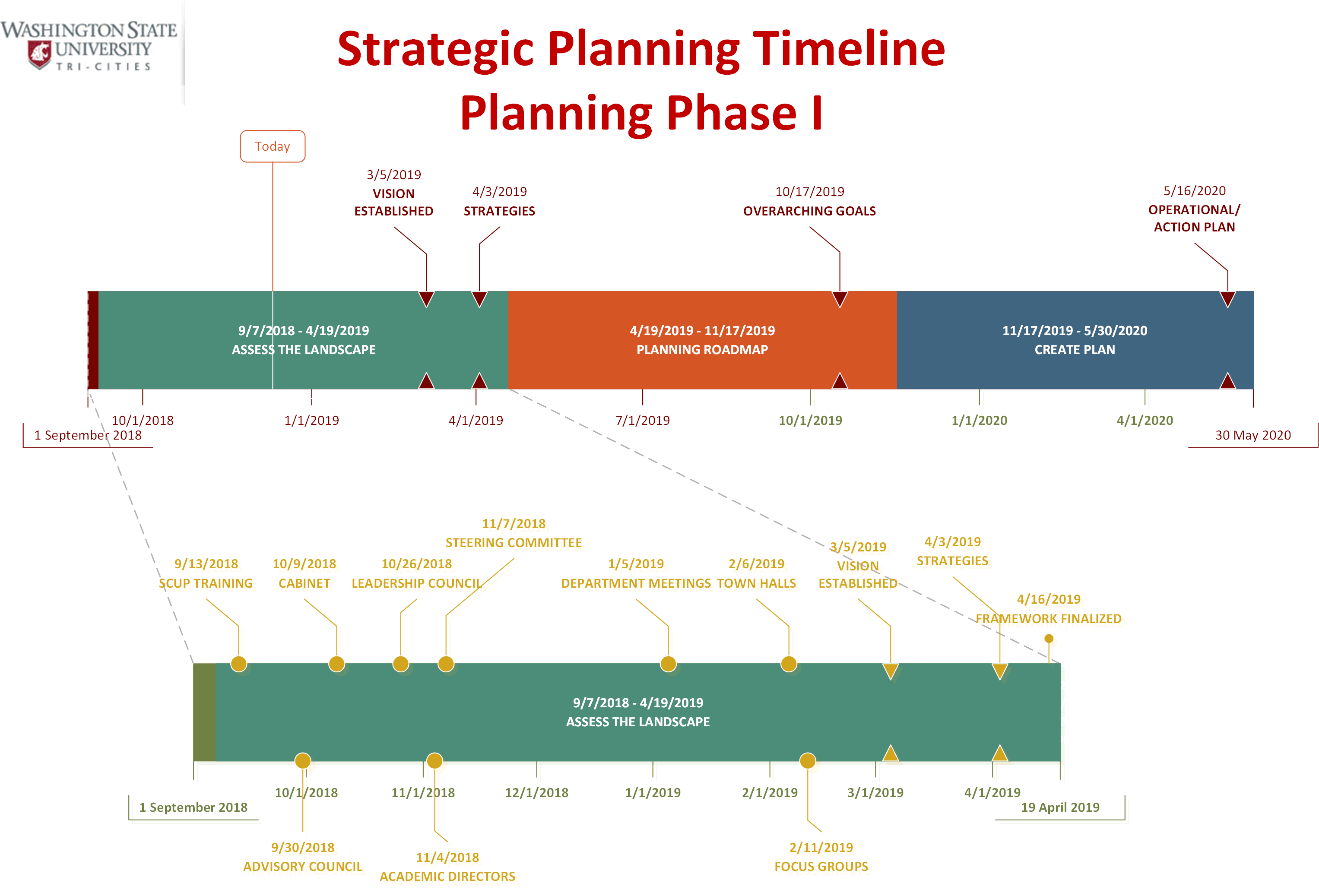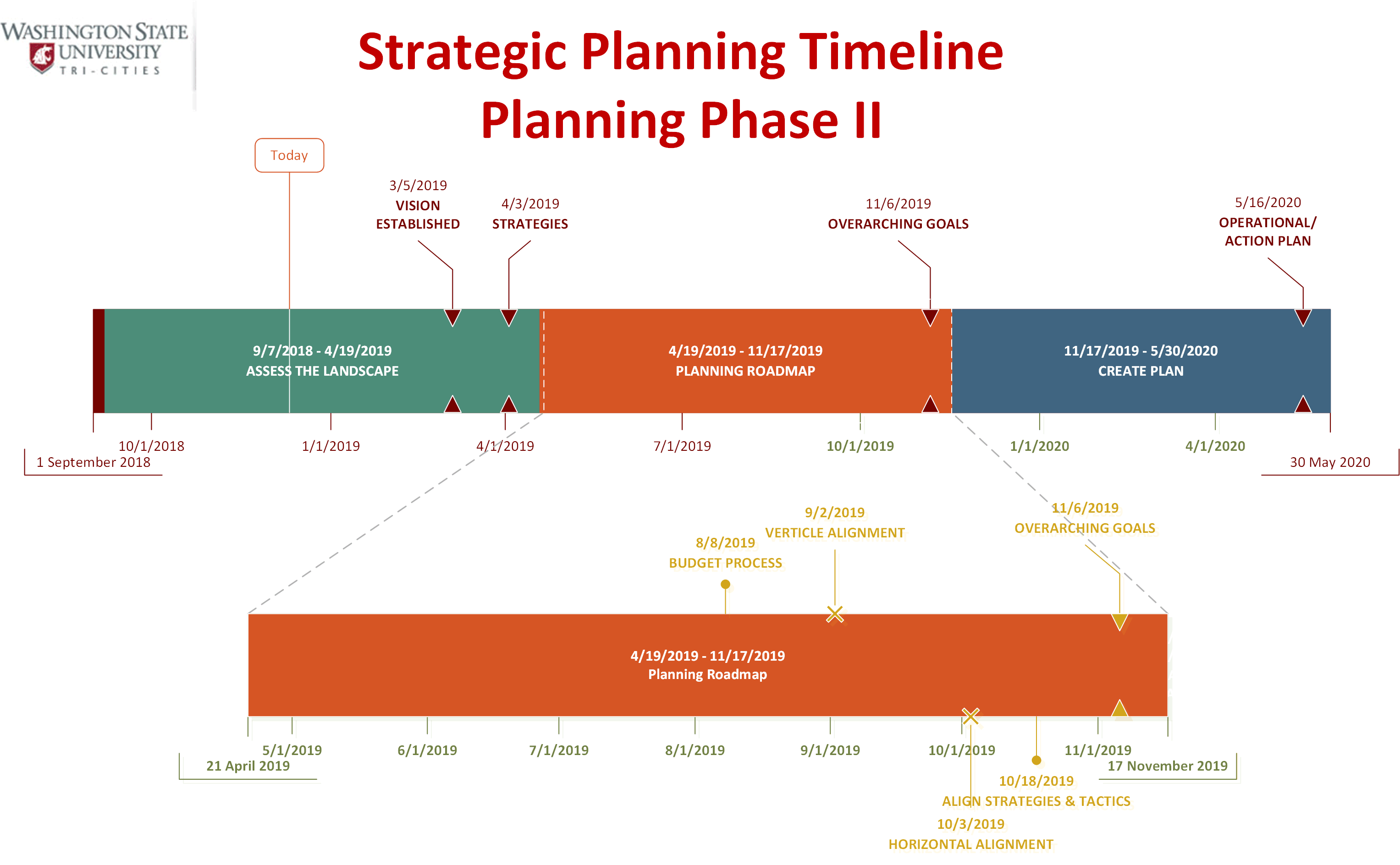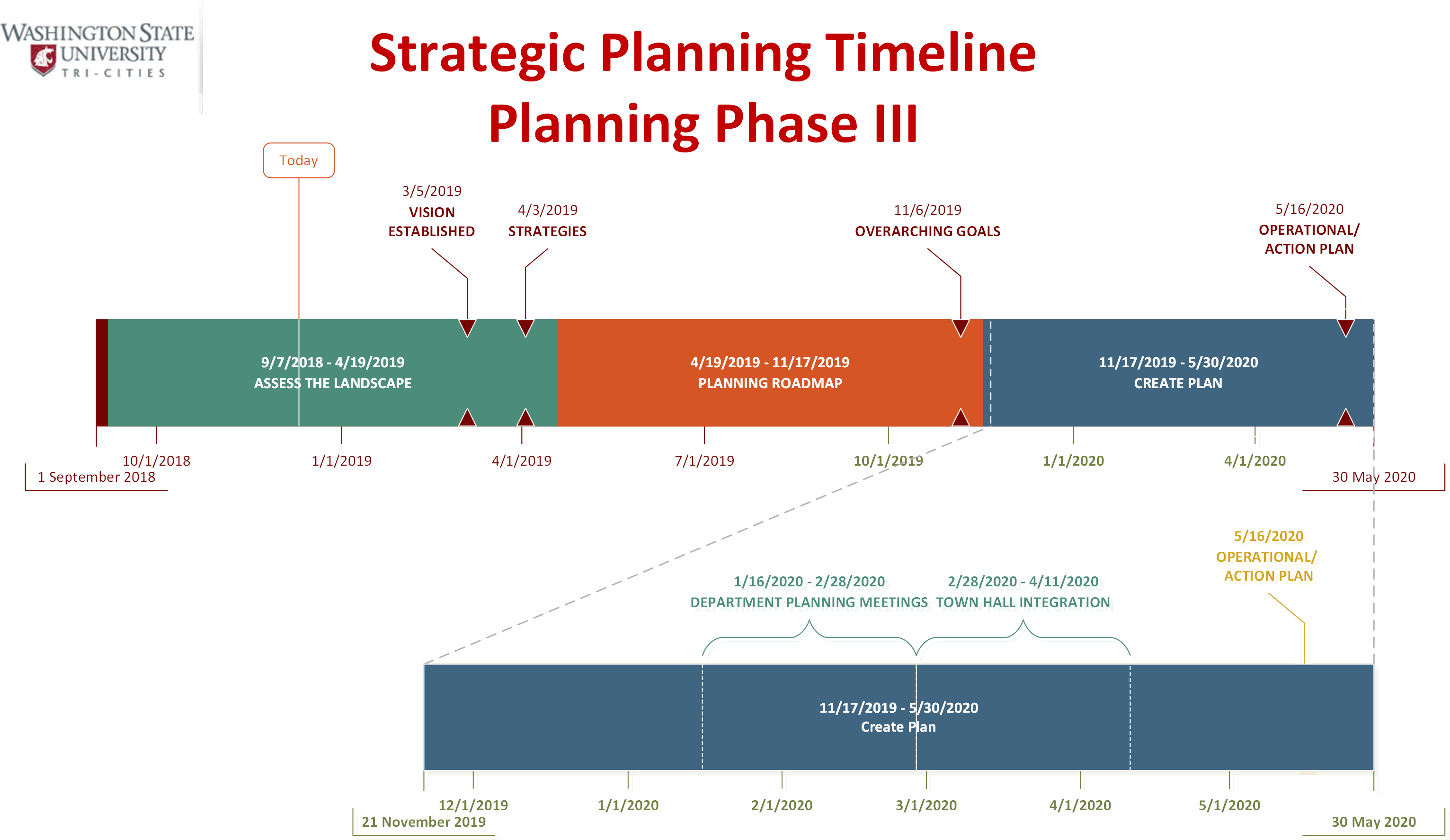WSU Tri-Cities enters an exciting time of transition looking to the next five years. In order to meet the needs of the Columbia Basin region, our campus will assess our context that includes our capabilities, capacity and prioritized steps needed to develop programs and campus infrastructure. This assessment process started in September of 2018 and will continue through January of 2020. We will implement our plan in the spring of 2020.
Baseline Information
Our mission is to…
-
- To advance knowledge through creative research and scholarship across a wide range of academic disciplines.
- To extend knowledge through innovative educational programs in which emerging scholars are mentored to realize their highest potential and assume roles of leadership, responsibility, and service to society.
- To apply knowledge through local and global engagement that will improve quality of life and enhance the economy of the state, nation, and world.
The Strategic Planning Steering Committee collected input from the Leadership Council, staff, faculty, Academic Directors, Deans, and Central WSU Administration to identify four planning criteria. Click below to learn more about these criteria.
Rigorous:
Our planning must be integrated throughout all aspects of our work allowing for diverse perspectives and inclusiveness. We must be willing to be held accountable, bravely reflect and be ready to revise.
Resilient:
To make our campus strong in the face of change, we follow reflective processes, ensure sustainability (fiscal, personnel, programming), and be adaptive to our environment by evolving as needed.
Relational:
A team relationship is at the core of our success involving the hometown community, students, faculty, staff, community colleges, K-12 School Districts, WSU Systems (campuses and colleges) and industry in order to strengthen communication and build trust.
Relevant:
We place high value on our work that contributes to the University, its Drive to 25 goal, our diverse community, and our students through the creation, sharing, and application of knowledge.
The Process
WSU Tri-Cities uses the SCUP process because it is specifically designed for higher education. The SCUP process uses an integrated planning model to gain an accurate picture of our external environment, ask hard but necessary questions, and build actionable plans.
Phase 1: Assess. The Landscape
Phase I: Assess the Landscape focuses on preparation for planning. During Phase I there are structures established for communications, information collecting, and common learning by the organization’s constituents about both external and internal contexts. First Chancellor Haynes appointed a “Steering Committee” to guide and inform the work of planning. Second, the Steering Committee identified four key characteristics needed by all involved with the planning: Rigor, Relationship, Resilience, and Relevance. Next a timeline was established to ensure the entire community was engaged and provided opportunity to understand our context and share their perspectives on the vision and values of WSU Tri-Cities. All of the activities are designed to engage and collect feedback from students, staff, faculty, industry partners, community members, and educational partners from across the Columbia Basin to inform the campus vision and values. The final outcome of Phase I will be an established vision statement by Chancellor Haynes and a Planning Framework from which the entire campus community will use to develop the strategic action plan.
Phase II: Planning Road-map
Phase II, “Planning Road-map” establishes a strategic framework from which actions can be identified in Phase III. The campus goals are organized into a framework that emerged from constituent input as our campus analyzes the campus context. By the end of Phase II, we will design a “framework” document outlining the campus vision, campus values, a process for Phase III, a communication plan, and stakeholders to engage.
Strategic Planning Committee Members:
Sandra Haynes – Executive Sponsor
Sarah Tragesser – Co-Chair
John Mancinelli – Co-Chair
Ray White – Coordinator
Eadie Balint – Civil Service Representative
Christopher Cree – Administrative Professional Representative
Patrick Jensen – Community Representative
Brian Moreno – Community Representative
Mohammed Osman – Faculty Representative
Paul Carlisle – Community Representative
Anna Plemons – Faculty Representative
Kathleen McAteer – Leadership Representative
Jordyn Creighton – Staff Representative
Maegan Murray – Staff Representative
Oscar Carrillo – Student Representative
Zachary Harper – Student Representative
Schedule of Fall 2019 Process:
Meeting #1: 11/1/2019
– familiarize committee with campus feedback and Organizing into groupings. Homework: Review baseline data
Meeting #2: 11/22/2019
– Drafting goals; Consensus on 2 goals per theme. Homework: Share goals with stakeholders
Meeting #3: 12/5/2019
– Revise goals based on feedback; Homework: Share out as needed or preferred
Meeting #4 12/13/19
– Refine goals & begin brainstorming strategies; Campus and community feedback open through 1/15/19.
Phase III: Create Action Plan
Phase III puts the Campus Goals from Phase II into action by describing the tasks needed to achieve the stated goals. The work outlined in this section is directed at the department level and requires input and prioritization from those closest to enacting the tasks. Many call this the “Action Plan.”
Communication Information Inputs
Format Audience(s) Message Time Period
“Vision & Values” survey Faculty, Staff, Students, Alumni, K12 partners, Community College partners, industry, high school students, Community, Deans, Central Administration. What do you value about WSU Tri-Cities?
How do you see WSU Tri-Cities mature in the next five years?
What can WSU Tri-Cities do better?
What barriers do you see?September 2018 – December 2018.
“Comment Box” Faculty, Staff, Students, Alumni, K12 partners, Community College partners, industry, high school students, Community, Deans, Central Administration. What input might you suggest to help WSU Tri-Cities better serve the Columbia Basin region? September 2018 – September 2019
Department Meetings Faculty Understand External Context
Identify capacities and capabilitiesJanuary 2019 – February 2019
Economic Town Hall Faculty, Staff, Students, Advisory Council, Community To learn of our communities economic and social trends. January 2019
Capacities & Capabilities Survey Faculty, Staff, Students, Alumni, K12 partners, Community College partners, industry, high school students, Community, Deans, Central Administration. Identify perceived campus capacity and capabilities. February 2019
Focus groups current students, faculty, staff, community members, industry partners, and potential students To clarify vision for next five years.
Clarify capacities and capabilities.March 2019 – May 2019
Market Analysis Faculty, Staff, Students, Alumni, K12 partners, Community College partners, industry, high school students, Community, Deans, Central Administration. To collect information about our programming market and student market. January 2019-May 2019
Campus Data Walk Faculty, Staff, Students, Advisory Council March 2019
Brown-bag Luncheons Faculty, Staff, Students Learn of planning progress and April 2019
Market Analysis Town Hall Faculty, Staff, Students, Advisory Council, Community Present findings from market research. April 2019
Leadership Council Faculty, Staff, Students Monthly updates and input September, October, November, January, February, March, April, May
Communication Information Outputs
Format Audience(s) Message Time Period
Chancellor’s Newsletter Faculty, Staff, Students, Alumni, K12 partners, Community College partners, industry, high school students, Community, Deans, Central Administration. Updates of most current information collected, discussed, and synthesized. 2 times per month, December – open
Currents Monthly publication Faculty, Staff, Students, Alumni, K12 partners, Community College partners, industry, high school students, Community, Deans, Central Administration. Updates of most current information collected, discussed, and synthesized. January 2019 – open
Department Meetings Faculty Understand External Context
Identify capacities and capabilitiesJanuary 2019 – February 2019
Economic Town Hall Faculty, Staff, Students, Advisory Council, Community To learn of our communities economic and social trends. January 2019
Campus Data Walk Faculty, Staff, Students, Advisory Council March 2019
Brown-bag Luncheons Faculty, Staff, Students Learn of planning progress and lessons learned. April 2019
Market Analysis Town Hall Faculty, Staff, Students, Advisory Council, Community Present findings from market research. April 2019
Leadership Council Faculty, Staff, Students Monthly updates and input September, October, November, January, February, March, April, May
Archive Hall Faculty, Staff, Students, Alumni, K12 partners, Community College partners, industry, high school students, Community, Deans, Central Administration. Updates of most current information collected, discussed, and synthesized. January 2019 – open
Webpage Faculty, Staff, Students, Alumni, K12 partners, Community College partners, industry, high school students, Community, Deans, Central Administration. Updates of most current information collected, discussed, and synthesized. December 2019 – open
Chancellor’s Community Presentations Chamber of Commerce, Research District, TRIDEC, Rotary, Advisory Council, Board of Regents, Provost’s Council, President’s Cabinet. Update of the work campus has completed and ways they can provide input and support. May 2019 – December 2019
Definitions
Word Definition
Alignment: A state of agreement and cooperation among individuals, groups, processes, documents, etc., about what should be done, how, and why.
Capabilities: What is the institution doing and how well? Basic capabilities are what every institution of higher education should be proficient in. Distinctive capabilities are what our campus does well, what the stakeholders value, and what our competitors can’t beat.
Communication plan: A document that outlines how you will inform, engage with, and seek feedback from your plan’s stakeholders, including specific audiences, messages, delivery methods, and frequency.
Competition: When multiple organizations try to provide value to the same group of users.
Competitor: An individual or organization that provides a similar program or service to the same users as our campus.
Environmental scanning: An exploration and analysis of the external factors affecting an institution both within and outside of higher education.
Framework: A concise outline of common language, priorities and parameters developed for the purpose of guiding Phase III: Creating a Strategic Action Plan.
Horizontal Alignment: The coordination of groups across boundaries so they effectively work together towards the same goals.
Implementation team: The group of people who coordinate the implementation of the strategic plan in Phase III.
Institutional Context: An institution’s distinct set of challenges, conditions, and history that shape planning and strategy.
Integrated planning: A sustainable approach to planning that builds relationships, aligns the organization, and emphasizes preparedness for change. The planning engages all sectors of the academy (academic affairs, student affairs, business and finance, campus planning, information technology, communications, development, advisory councils, Board of Regents, WSU central administration/leadership/provost. Integrated planning involves all stakeholders (faculty, students, staff, alumni, and external partners) to work together toward a common vision.
Mandates: What must the institution do? Formal mandates are codified in laws, regulations, ordinances, articles of incorporation, charters, policy, and by-laws. Informal mandates are commonly embodied in norms or expectations of key stakeholders, such as local or regional electorate, elected representatives, local employers, or major donors.
Mission: An institution’s purpose or reason for existence, often articulated in a mission statement.
Organizational Capacity: What can the institution do?
Organizational Culture: A system of assumptions, values, and beliefs that drives behaviors, actions, roles, and practices in an organization.
Planning team: A formal group of people assembled to prepare a plan in Phase II.
SMART Goals: Specific, Measurable, Achievable, Relevant and Time-bound goals typically articulated in Phase III.
Stakeholder: An internal or external person, group, or organization that will affect or be affected by an institution’s choices and actions.
STEEP Analysis: Social, Technological, Economic, Environmental, and Political analysis of our campus context. Social analysis looks at how people work internally and with each other. Technological analysis looks at how people use technology (hardware/software), how society relies on technology, and how technology affects society. Economic analysis looks at both macro/micro levels including global trends, anything related to jobs and skills needed for jobs, and industry shifts. Environmental analysis looks at our external surroundings, including sustainability and our evolving workplaces, cities, and living spaces. Political analysis looks at public policy, governmental systems, the people within them, and the effects of government decisions on our citizens and communities.
Strategic issues: Pressing problems and/or significant opportunities that must be strategically addressed for an institution to meet its mission and/or remain operationally viable
Strategic planning: A deliberate, disciplined effort to produce fundamental decisions and actions that shape and guide what the institution is, what it does, and why it does it.
Strategic plan: A product of the strategic planning process that documents and communicates decisions made during the planning process.
Steering Committee A small group appointed by the Chancellor to guide the development of the planning Phase I.
SWOT Analysis: A structured planning method used to evaluate internal (strengths and weaknesses) and external (opportunities and threats) factors affecting an institution, department, project, industry, or person.
Values: The guiding principles or beliefs of a person or an organization.
Vertical Alignment: The direct connection of desired outcomes from mission to on-the-ground operations.
Vision: A description of what an institution (and key parts of the external environment) will look like if the institution succeeds in implementing its strategies and achieves its full potential.
Archive Hall
Archive Hall will be located in room East 228. Over the course of our process, documentation and contextual information will be housed here for our community to review. Additionally, department meetings and social meetings will occur here in order for people to review what we have learned and view sources of information.
Here are resources for your learning…




